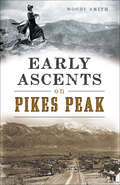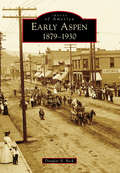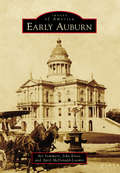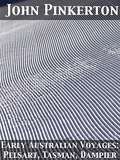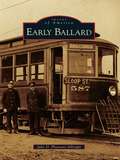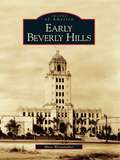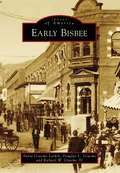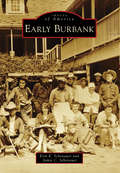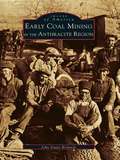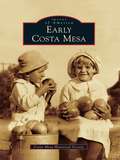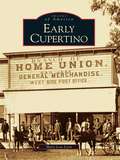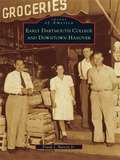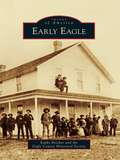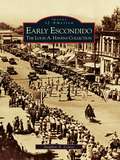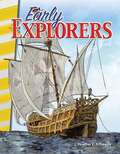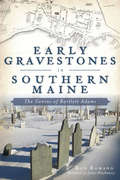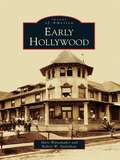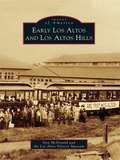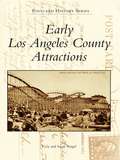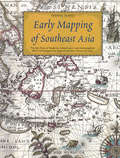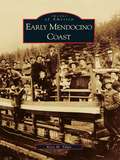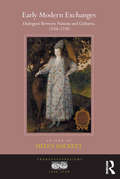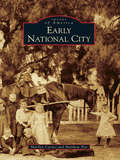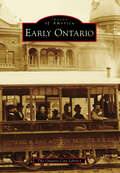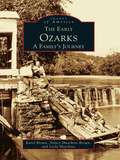- Table View
- List View
Early Ascents on Pikes Peak (American Chronicles Ser.)
by Woody SmithAn intriguing, firsthand look at what it was like to ascend the storied Colorado mountain and experience its allure in the early days of the Old West. Magnificent Pikes Peak rises dramatically from the Colorado prairie to a height of 14,114 feet above sea level. Visible for one hundred miles around, the granite giant&’s magnetic appeal compelled rugged mountaineers more than a century ago to risk loose saddles, electrical storms and even murder on treacherous expeditions to the summit. First known as Long Mountain by the Indigenous peoples who sojourned at its hot springs, Pikes Peak was a full-fledged tourist destination by the 1870s. Eager men and women ventured up and down by foot, horse, burro, stagecoach, rail and bicycle. Colorado Mountain Club historian Woody Smith captures the news of the era to recount the thrill of pioneer days on America&’s most famous mountain.
Early Aspen: 1879-1930
by Douglas N. BeckUntil 1879, the Roaring Fork Valley was home to a band of Colorado Ute Indians. All of that changed in the summer and fall of that year, when two prospecting teams came to the valley to stake their claims, some of which went on to produce millions of dollars of silver. Within five years, Aspen was home to over 20,000 individuals including miners, lawyers, families, businessmen, and even prostitutes. Aspen's fortune was tied to silver. More importantly, its fate was ultimately tied to the Sherman Silver Purchase Act of 1890, which required the US government to buy 4.5 million ounces of silver per month. From 1890 to 1893, the Sherman Act kept Aspen alive and growing. With the repeal of the act, Aspen began a slow, painful decline. This book covers the years of Aspen's discovery, through the years of decline, and into what is known as the "Quiet Years."
Early Auburn
by John Knox Art Sommers April Mcdonald-LoomisLocated at the junction of gold-rich ravines, Auburn was the site of the first gold discovery in Placer County. Though the superficial gold was quickly panned out, by 1850, the town had become an important trading center. Auburn became a center for goods, services, entertainment, and a place for miners to "winter-over." More importantly, it became a transportation hub. As the county seat, Auburn's hotels, saloons, and merchants experienced a steady stream of customers as county residents came to town to deal with legal matters. Though plagued by numerous destructive fires, the citizens of Auburn rebuilt, and the town continued to thrive. This book will introduce the reader to some of the individuals who were instrumental in shaping Auburn as it grew into the town it is today.
Early Australian Voyages: Pelsart, Tasman, Dampier
by John PinkertonThe Essential Library presents John Pinkerton's "Early Australian Voyages," a captivating account of true-life stories of courage and daring. Meet the brave explorers who were the first to cross the uncharted seas.
Early Ballard
by Julie D. Pheasant-AlbrightThe first land claim in what would become the city of Ballard was made in 1852, but it wasn't until a ship captain named William Rankin Ballard lost a bet with a business partner and found himself the owner of 160 acres of seemingly worthless land that the city prospered and became the "Shingle Capital of the World." Incorporated in 1890, Ballard grew quickly, thanks to shingle and lumber mills and the Scandinavian fishing fleet. When a horse was supposedly found in the city water supply in 1906, reluctant Ballardites voted to be annexed to the city of Seattle, and the flag flew at half-staff at Ballard City Hall. Home to the Nordic Heritage Museum, Chittenden Locks, and the fishing fleet, this bustling city-within-a-city still retains its unique Scandinavian flavor to this day.
Early Beverly Hills
by Marc WanamakerWay before Rodeo Drive and the "pink palace" of the Beverly Hills Hotel were built, way before the namesake hillbillies, its zip code, and Eddie Murphy's detective techniques reaffirmed its place in popular culture, and way before its 1,001 mansions, Beverly Hills was comprised of wild canyons and ranchlands. Burton Green, one of the three original land developers of the Rancho Rodeo de las Aguas, named this place of severe terrain after Beverly Farms, Massachusetts, a 19th-century spa. Since its establishment in 1907, Beverly Hills, California, has been a crossroads for the great movers and shakers of the entertainment industry as well as the tycoons, world leaders, and flotsam and jetsam magnetized by the limelight. The vintage photographs in this provocative volume illustrate Beverly Hills's early transition from cow pastures to Hollywood's extremely illustrious bedroom community.
Early Bisbee
by Annie Graeme Larkin Douglas L. Graeme Richard W. Graeme IVBefore Bisbee became a bustling mining camp, it was a haven to Native Americans for centuries. However, their presence brought the intrusion of army scouts and prospectors into the Mule Mountains. The coincidental discovery of vast mineral wealth at the future site of Bisbee permanently affixed the fate of the land forever. Rising from the remote desert was a dynamic mining city, a city that grew into one of the most influential communities in the West. Bisbee was unique in the Old West because of the mixed moral values. High society and the decadent underworld lived in a delicate balance, but a vibrant multicultural community was forged from these social fires.
Early Burbank
by Erin K. Schonauer Jamie C. SchonauerBurbank is an innovator, a world traveler--a city with artistic flair and creativity. From the entertainment industry taking up residence in the early 20th century to the Lockheed Aircraft Company opening shop in 1928, Burbank's masterpieces have transcended the coasts. Films shot on Burbank back lots and streets have entertained audiences worldwide. Lockheed planes built on Burbank soil flew across the world with the likes of Amelia Earhart and Charles Lindbergh. Once a robust farming community, Burbank, founded on May 1, 1887, and later incorporated as a city on July 8, 1911, dons its name from Dr. David Burbank, a New Hampshire-born dentist who, in 1867, bought over 9,000 acres of land amid the sun-kissed foothills of the Verdugo Mountains--land that was awaiting creative cultivation.
Early Coal Mining in the Anthracite Region
by John Stuart RichardsFour distinct anthracite coal fields encompass an area of 1,700 square miles in the northeastern portion of Pennsylvania. In the late nineteenth and early twentieth centuries, underground coal mining was at its zenith and the work of miners was more grueling and dangerous than it is today. Faces blackened by coal and helmet lamps lit by fire are no longer parts of the everyday lives of miners in the region. Early Coal Mining in the Anthracite Region is a journey into a world that was once very familiar. These vintage photographs of collieries, breakers, miners, drivers, and breaker boys illuminate the dark of the anthracite mines. The pictures of miners, roof falls, mules, and equipment deep underground tell the story of the hard lives lived around the hard coal. Above ground, breaker boys toiled in unbearable conditions inside the noisy, vibrating, soot-filled monsters known as coal breakers.
Early Costa Mesa
by Costa Mesa Historical SocietyThree emerging communities from the partitioned Rancho Santiago de Santa Ana formed the improbable start for a city that would eventually proclaim itself the "City of the Arts." These farming communities--Fairview, Paularino, and Harper--attracted families and businesspeople. Community leaders then took pragmatic steps to meet local needs such as schools, churches, and a water supply. Harper's first land developer appealed to folks of modest means by advertising, "You! Five Acres." By 1920, Harper needed a broader identity and a local businessman proposed a naming contest, offering a $25 prize. "Costa Mesa," recognizing the area's heritage and geography, reaped the reward. Eight years later, voters handily defeated the City of Santa Ana's annexation attempt by a margin of five to one. The Great Depression, the 1933 Long Beach earthquake, and the 1938 Santa Ana River flood then besieged the fledgling community. Undaunted, Costa Mesa continued to grow. By 1939, the stage had been set for the postwar miracle that would become the modern city of Costa Mesa.
Early Cupertino
by Mary Lou LyonA priest with Juan Batista de Anza's expedition in 1776 named a wild creek where the group camped after St. Joseph of Cupertino, Italy. A village known as Westside adopted the name in 1904 as it grew up by that stream, now Stevens Creek, near the road that is now De Anza Boulevard. Like its Italian namesake, Cupertino once had wineries, and vineyards striped its foothills and flatlands. Later vast orchards created an annual blizzard of spring blossoms, earning it the name Valley of Heart's Delight. The railroad came to carry those crops to market, and the electric trolley extended to connect Cupertino's first housing tract, Monte Vista. When the postwar building boom came, Cupertino preserved its independence through incorporation, but that bold move would not stop the wave of modernization that would soon roll over the valley.
Early Dartmouth College and Downtown Hanover (Images of America)
by Frank J. Barrett Jr.The town of Hanover, chartered in 1761, began as a sleepy, idyllic community nestled in the Upper Connecticut River Valley. In 1770, noted Connecticut minister Eleazar Wheelock chose to relocate his school, Dartmouth College, to a virgin wilderness corner of the struggling young township. In spite of hardships, within several years Wheelock and his small college had taken root on the Hanover Plain, joining together with the local community that would come to be known as the "Village at the College." Over the next two centuries, the college and the village would grow together in triumph and tragedy, rich in history and events, to become a special place revered by generations of alumni and residents alike.
Early Eagle
by Eagle County Historical Society Kathy HeicherNestled into a scenic mountain valley at the junction of the Eagle River and Brush Creek, Eagle is a small mountain town that is often overshadowed by its famous ski resort neighbor, Vail. However, this thriving little mountain community claims a rich history of more than 100 years of spunk and fortitude. Eagle's robust character started with the miners who came to the valley in the 1880s seeking gold and silver. Then came the farmers and ranchers, who recognized another type of wealth in the fertile soils and abundant water of the valley. As for that spunk, the townspeople of Eagle were tenacious enough to wage a 20-year war seeking county seat status and progressive enough to keep a small town growing and thriving for over a century.
Early Escondido: The Louis A. Havens Collection
by Stephen A. CoveyLouis A. Havens was a Southern California pioneer businessman, storyteller, and artist who brought the community of Escondido together via his camera. He was the first successful photographer in the thriving north San Diego County agricultural city, incorporated in 1888. Prior to his arrival, the occasional photographer might seasonally visit Escondido or attempt to set up shop, realizing little success. Havens's timing in his arrival, combined with his skillful eye, ensured his success from 1911 to 1944. His collection documents Escondido's early residents, architecture, events, and landscapes, and it now persists as a historic record of past events, culture, and development of the fourth largest city in San Diego County.
Early Explorers (Social Studies: Informational Text Series)
by Heather E. SchwartzBuild literacy skills and social studies content knowledge with the Early The Primary Source Readers series will ignite students' interest in history through the use of intriguing primary sources. This nonfiction reader features purposefully leveled text to increase comprehension for different learner types. Early Explorers teaches students about the fascinating explorers who mapped the world including the Vikings, Marco Polo, and Christopher Columbus. Text features include captions, a glossary, and an index to help build academic vocabulary and increase reading comprehension and literacy. This book prepares students for college and career readiness and aligns with state standards including NCSS/C3, McREL, and WIDA/TESOL.
Early Gravestones in Southern Maine: The Genius of Bartlett Adams
by Ron Romano James BlachowiczThe slate gravestones of southern Maine bear evidence to the region's fascinating history, from shipwrecks and famous wartime sea captains to countless ordinary citizens. Master stone-cutter Bartlett Adams memorialized the tragedy and triumph of the region in nearly two thousand gravestones. Examine the artistry of the headstones that mark the resting places of three generations of the same family who all went down with the schooner Charles, and discover the grief that Adams poured into the stones for his own three children. Through deep and original research, author and guide Ron Romano narrates the early history of southern Maine and one man's legacy, carved in stone.
Early Hollywood
by Marc Wanamaker Robert NudelmanThe image of Hollywood often translates as some otherworldly dreamscape filled with fantastic lives and fantasy fulfillment. The real deal was carved from the Southern California desert as an outpost northwest of Los Angeles. The movie industry arrived when tumbleweeds were not simply props and actual horsepower pulled the loads. Everyday workers, civic management, and Main Street conventionalities nurtured Hollywood's growth, as did a balmy climate that facilitated outdoor photography and shooting schedules for filmmakers. Splendid vintage photographs from the renowned collections of the Hollywood Heritage Museum and Bison Archives illustrate Hollywood's businesses, homes, and residents during the silent-film era and immediately after, as the Great Depression led up to World War II. These images celebrate Hollywood before and after its annexation into the city of Los Angeles in 1910 and its subsequent ascension as the world's greatest filmmaking center.
Early Los Altos and Los Altos Hills
by Los Altos History Museum Don McdonaldLos Altos would never have existed if not for the Southern Pacific Railroad. Since the 1850s, Los Altos, Spanish for "heights" or "foothills," was the name generally applied to the two ranchos (San Antonio and La Purisima Concepcion) between Palo Alto and Mountain View southwest of El Camino Real. In 1906, visionaries Paul Shoup, who worked for the railroad, and Walter Clark, a Mountain View real estate developer, saw the potential to turn Sarah Winchester's ranch near Stanford University into an ideal San Francisco suburb. They would capitalize on new commuters--those who wanted to live in comfort in the country but work in the city. Slowly, a new town grew in influence well beyond its original Altos Land Company plat, realizing tremendous post-World War II expansion. Now two communities solidly embedded in Silicon Valley, Los Altos and Los Altos Hills share a school system, downtown shopping, libraries, and water system, as well as a history of interesting people.
Early Los Angeles County Attractions
by Cory Stargel Sarah StargelWith the arrival of affordable transcontinental rail travel in the late 1880s, hundreds of thousands of tourists and transplants began making the trip to Los Angeles. Quickly becoming a haven for Easterners escaping cold winters and crowded cities, Los Angeles and neighboring communities, such as Pasadena and Santa Monica, boasted a sunny Mediterranean climate and the unique situation of both nearby mountain resorts and seaside amusements. The city also developed a bustling shopping and entertainment district downtown. More than 200 vintage postcard images illustrate a greatly diverse range of popular early attractions, including Mount Lowe, Eastlake Park, Hollywood, the Wilshire district, Griffith Park, Cawston's Ostrich Farm, the downtown shopping and theater district, and the expansive beaches, ranging from the turn of the 19th century up until World War II.
Early Mapping of Southeast Asia
by Thomas SuarezEarly Mapping of Southeast Asia follows the story of mapmaking, exploration and colonization in Asia from the 16th to the 19th centuries. It surveys Southeast Asia's geography and civilizations, its maps and their influence on Western worldviews, as well as the image of Southeast Asia in the eyes of its neighbors.
Early Mendocino Coast
by Katy M. TahjaDriving Highway 1 along the Mendocino coast is a scenic adventure that draws thousands of visitors every year. Following the coast from Gualala on the south to Needle Rock in the north can be a challenge and features back-road driving. But imagine 100 years ago. Were there roads then too? How did people move along the coast? And what were they doing? Why did they settle here? Forget the Gold Rush and the forty-niners--timber was king here. Logging, milling, and shipping wood was the focus of the economy. Railcars steamed through the forests, and ships pulled up to rickety landings to load shipments for faraway places. Today some coast views remain the same, while others have changed dramatically, and whole towns have vanished over the century.
Early Modern Exchanges: Dialogues Between Nations and Cultures, 1550-1750 (Transculturalisms, 1400-1700)
by Helen HackettMarcus Gheeraerts’s portrait of a ’Persian lady’ - probably in fact an English lady in masquing costume - exemplifies the hybridity of early modern English culture. Her surrounding landscape and the embroidery on her gown are typically English; but her head-dress and slippers are decidedly exotic, the inscriptions beside her are Latin, and her creator was an ’incomer’ artist. She is emblematic of the early modern culture of exchange, both between England and its neighbours, and between Europe and the wider world. This volume presents fresh research into such early modern exchanges, exploring how new identities, subjectivities and artefacts were forged in dialogues and encounters between diverse cultures, nations and language communities. The early modern period was a time of creative interactions between cultures and disciplines, and accordingly this is a multidisciplinary volume, drawing together international experts in literature, history, modern and ancient languages and art history. It understands cultural exchange as encompassing both the geographical mobilities of travel and trade and the transmission of ideas across borders and between languages, as enabled by the new technology of print. Sites of exchange were located not only in distant and unfamiliar lands, but also in the bookseller’s shop and the scholar’s study. The volume also explores the productive and complex dialogues between early modern culture and the classical past. The types of exchanges discussed include the linguistic transactions of translation and imitation; interactions between cultural elites, such as monarchs, courtiers and diplomats; and the catalytic influences of particularly mobile or outward-looking individuals and groups. Ranging from the neo-Latin poetry of an English author to the plays of a nun in seventeenth-century New Spain, from royal portraits exchanged in diplomatic negotiations to travelling companions in the Ottoman Empire, the volume sheds new light
Early National City (Images of America)
by Marilyn Carnes Matthew NyeBelow the surface of bustling National City lies the story of olive and citrus orchards, grand Victorian homes, great wealth, and the coming of the first railroad. Founded in 1868 by Frank Kimball, National City is credited with multiple distinguished firsts. On the county level, the San Diego County Fair originated here, the first novel published was by a National City pioneer, the first free kindergarten opened here, the first automobile was built here, and the first railroad terminus was located here. On the state level, the first woman to serve as an elected member of a school board lived in National City. Today the city is home to 61,000 residents; and as an accessible and diverse community, all eyes now look upon National City as it begins to experience a renaissance of growth and commerce.
Early Ontario
by The Ontario City LibraryGeorge and William Chaffey, immigrants from Canada, founded a model colony in Southern California in 1882. They named their settlement Ontario, from an Iroquois term meaning beautiful water, not only to pay homage to their home province but to also draw other Canadians to their colony. Utilizing forward-thinking irrigation practices, the brothers laid out plots of land ready for colonists who wanted to farm or raise citrus groves. After just four years, the brothers left for Australia to develop more settlements and passed their model colony on to Charles Frankish and his partners of the Ontario Land and Improvement Company. From its earliest days, the colony became known for its citrus groves, Armstrong roses, Graber olives, Guasti grapes, and the Hotpoint iron. This book, which includes nearly 200 images, focuses on the colony's early development.
Early Ozarks, The: A Family's Journey
by Nancy Mashino Brown Karol Brown Leola MashinoDomino Danzero's journey, which began in Italy in 1890, led him penniless to New York. The young immigrant came to the Midwest and found work in the coal mines of Illinois and the restaurants of Chicago. Through his travels and his work he gained employment with the Frisco railroad, where he became the overseer of Harvey Houses and Frisco dining cars throughout the central United States. Photography was his hobby and he was commissioned to take photographs for the Frisco railroad. The turn-of-the-century photographs featured in The Early Ozarks: A Family's Journey portray the humanness of people living in the Ozarks. They provide a glimpse of thebetter things in life--food, family, and friends--reflecting fundamental human compassion and the way of living at the early part of the twentieth century.
